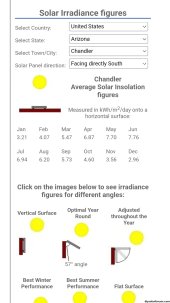GXMnow
Solar Wizard
- Joined
- Jul 17, 2020
- Messages
- 2,711
No, not even close.or 7-8 in winter, like we do.
You may have 7-8 hours of daylight, but the sun is at such a low angle, the energy is much lower.
One "Sun Hour" is an amount of sunlight that will produce 100 watt hours from a 100 watt solar panel, but it may take 4 hours to get it. I am in a very sunny area, and in summer, we rarely hit 7 sun hours a day. And in the winter, it can fall under 3 sun hours even on a clear day. Add in clouds, and it falls to just 1 sun hour all day.
Look up "Solar irradiance at my location" and you should be able to find a chart or calculator to find this data. I have used this one and it is a pretty good estimate.

Solar Irradiance Calculator
I typically get 80 to 90% of the estimate from this site each month. I think most of that error is that it does not allow exact panel angles, and I have some shading in both the early morning and the late evening. And my power reading is after the inverter which has some loss and also clips a little near noon on sunny but cold days.
For the whole year, my 4,800 watts of solar panels produce right about 8,000 kilowatt hours. That is an average of just over 4.5 sun hours a day.






